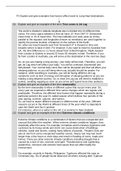P3 Explain and give examples how factors affect travel to Long-Haul destinations.
Q1 Explain and give an example of the term Time zones & Jet Lag
The world is divided in latitude longitude plus is divided into 24 different time
zones. For every space between a line we have 15° from GMT 0° (Greenwich
mean time) or 1h of travel time. The lines latitudes (run east–west as circles
parallel to the equator) and longitudes (known as meridians) are used together to
specify the precise location of features on the surface of the Earth.
So, when we travel towards east from Greenwich 0° is forward in time and
towards west it is back in time. For instance, if you want to travel to Australia from
UK, the time difference is 11 hours ahead from United Kingdom. Flight duration
from London to Sydney is around 22 hours 50 minutes in total. Therefore, if you
fly from London to Australia, you will arrive at the destination in the next two days.
So, as you are making a long journey, your body will be tired. Therefore, you will
get Jet Lag which will affect your body. You will be confused, disoriented and
dehydrated. Your normal body clock then will be disrupted and that will affect your
sleeping patterns, so you will sleep when you actually should be awake. For
instance, while travelling to Australia, you will be facing different Jet Lag
symptoms such as lack of energy and disruption of sleeping patterns as you are
making a long distance journey. So, to treat Jet Lag you will need to establish a
routine, avoiding napping as soon as you arrive and spend more time outdoors.
Q2 Explain and give an example of the term seasonality
By the term seasonality it refers to different cycles that occurs every year. So,
every year we experience different time series changes which are regular and
predictable. Therefore, the different time frames that happen repeatedly during a
particular period in the year it’s called season which defines four periods of the
year (spring, summer, autumn, and winter).
So, we have to aware different seasons in different time of the year. Different
seasons occurs in the World at different times of the year which is dependent
upon the Earth and Sun’s position.
For instance, when it is winter in the UK, it is summer in New Zealand.
Q3 Explain and give an example of the term Extreme climatic conditions
Extreme climate conditions is a combination of factors that are unexpected and
unusual that affect the weather. When extreme climate conditions happen, they
drastically affect the area. For example, tornadoes and hurricanes (typhoons and
cyclones) by its heavy windy and storm can cause destruction of buildings,
vehicles, roads and homes, costing many billions of pounds. People’s lives are
also at risk from some unexpected weather events. Heavy rain may last much
longer than a few hours or even days and result in flooding of rivers, roads and
homes. There are other extreme climate conditions including drought that is
caused by a lack of rain, extreme cold spell, Thunderstorms and Lightening,
avalanches, monsoon and extreme heat waves that can affect badly the
environment.
For example, recently in Manila, Philippines, Typhoons affected the area on
Christmas Day. Six of people found dead and 18 others missing after Typhoon




